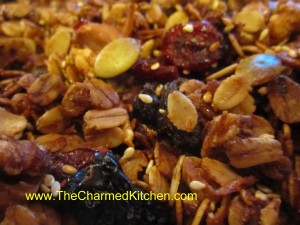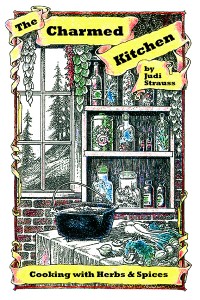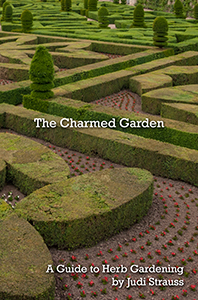Cooking and Baking with Honey
Honey has been a favorite sweetener since prehistoric times and still has advantages over sugar even today. Honey is composed of two simple sugars, glucose and fructose. Honey is absorbed in a different manner and therefore causes a slower, more gradual rise in blood sugar. Because honey has a slightly higher percentage of fructose than sugar, it tastes sweeter, and less is required for equal sweetness.
Honey contains small amounts of numerous vitamins and minerals, but not enough to fulfill any of the body’s daily needs. Remember that honey does contain calories, cannot be used freely by a diabetic and is not recommended for infant formulas.
The flavor, aroma and color of honey vary with the kind of flowers from which the bees gather the nectar used to make the honey. The fructose gives honey its sweet flavor, and the nectar adds the characteristic taste of the floral source to your recipes. Generally, the lighter the honey, the milder the flavor. If a stronger flavor is desired for your recipe, use a darker, stronger flavored honey; if a more delicate flavor is desired, use a lighter, milder flavored honey.
Honey can easily be substituted for sugar. Due to honey’s ability to retain water, products made with honey tend to remain moister longer than similar products made with sugar or other sweeteners.
Some minor adjustments may need to be made to a recipe when substituting honey for sugar:
- Use equal amounts of honey for sugar up to one cup. Over one cup, replace each cup of sugar with 2/3 to 3/4 cup over honey depending upon the sweetness desired.
- Lower the baking temperature 25 degrees and watch your time carefully since products with honey brown faster.
- In recipes using more than one cup honey for sugar, it may be necessary to reduce liquids by 1/4 cup per cup of honey.
- In baked goods, add 1/4 teaspoon of baking soda per cup of honey if baking soda is not already included in the recipe. This will reduce the acidity of the honey, as well as increase the volume of your product.
Moisten a measuring spoon or cup first with water, oil, or an egg before measuring the honey to prevent it from sticking to the measuring utensil. Honey is heavy by weight. A 12 ounce jar equals one standard 8 ounce cup. A quart weighs 3 pounds.
Honey Saves the Day
When you are melting chocolate, it will sometimes seize. This normally happens when liquid gets in the melted chocolate. That’s why you have to be careful when using a double boiler. A few drops of water can spell disaster. It becomes grainy and hard and usually just gets tossed out. But, if you add a little honey to the chocolate and stir it in gently the chocolate softens and can still be used!!!!
Mom’s Cold Remedy
When I was a kid I remember my mother making her all-purpose combination for making her feel better, if she had a cold or sore throat. She would mix equal parts of honey, whiskey and lemon juice. She said the secret was just to take small sips throughout the day. Not sure if it really helped, but you certainly felt better if you sipped it all day!! For a non-alcohol version try equal parts honey, lemon juice and apple cider vinegar.
Homemade Granola
3 c. rolled oats
1/4 -1/2 c. each of any of the following to equal 1-2 c. total
Sesame seeds, sunflower seeds, chia seeds, wheat germ, peanuts, pecans, almonds, hazel nuts, pumpkin seeds, walnuts, coconut… you get the idea. Don’t forget to chop up any big pieces.
1 t. cinnamon
1 t. orange peel
1/2 t. nutmeg
pinch of salt, optional
1/4 c. oil
1/4 c. honey- or add a little more if you like a sweeter granola
2 t. vanilla
Dried fruit to equal 1 -1 1/2 cups. Some choices could include: raisins, dried cranberries, cherries, pineapple, dates, figs, apricots, bananas, blueberries etc.
In large bowl combine oats with seeds and nuts and toss well with seasonings. Heat together oil, honey and vanilla and pour over oat mixture, tossing to coat evenly. Spread on a cookie sheet and bake in a 300-degree oven for 30 minutes. Halfway through the baking time stir mixture so the edges won’t burn. Remove from oven and return to large bowl. Toss with the dried fruit and allow to cool before storing in an airtight container in a cool, dry place. Use in 1 month or store in freezer or fridge to keep longer. Makes 5-7 cups.
Honey Ginger Cough Drops
½ c. honey
2 T. lemon juice
1 t. freshly grated ginger root
Optional for dusting: ¼ cup powdered sugar and 1 t. powdered vitamin C
Kitchen items you will need: a candy thermometer, a candy mold with small openings. You can make the cough drops without the mold; oil a piece of parchment paper and pour the candy onto it. Let it harden, and then break it up into small pieces.
Measure the honey, lemon juice, and grated ginger and pour it all into a saucepan.
With a wire whisk, stir the mixture as it heats to a boil. It will become foamy and start to climb up the sides of the pan, remove it from the heat and continue to whisk it until the foam reduces and then put it back over the heat. Repeat this until a candy thermometer reads 300 degrees. You will want to check frequently because the honey heats fast and scorches easily!
If you don’t have a candy thermometer, you can also test for readiness this way. Drop a bit of the mixture into a glass of ice water (or, dip a spoon into the mixture and then quickly dip it into the ice water). If the mixture forms a hard, crunchy ball, it’s ready! If not, keep up with the whisking and heating and try again in a minute or so. Once a hard ball forms in the ice water, you’re good to go!
Let the mixture cool until the foam has reduced. Then, very carefully, drizzle the candy into the mold (or onto the oiled parchment paper). Let it cool at room temp until the cough drops are hard. When they are hard, press on the back of the mold to release. Or, if you’re not using a mold, break the cough drops up into pieces.
Optional (to prevent sticking): In a small bowl, mix the powdered sugar with the vitamin C powder. Drop the finished cough drops into the mixture to coat. Pour the sugar and cough drops into a sieve and sift to remove extra sugar. Store in an airtight container. These actually do better in the fridge, as they attract moisture and tend to get sticky if left out.





